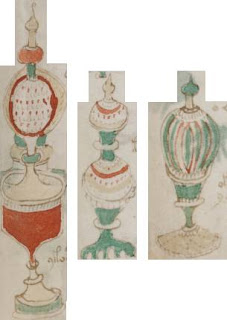I just stumbled upon a January 2008 paper on translating nonsense texts in Translation Studies journal, written by Jean-Jacques Lecercle from the University of Nanterre, for the simple reason that it happened to discuss the (apparently nonsensical) Voynich Manuscript.
Plainly, Gordon Rugg’s hoax-theory fan-club (which I guess used to be Terence McKenna’s hoax-theory fan-club) has been all too successful in its drive for new members: but really, ’tis pity she’s no hoax.
Though I wasn’t quite intrigued enough by the article’s abstract to pay Informaworld the required £15 + VAT to download it, its mention of Callois’ ludus and paidia did get me thinking, particularly considering my background as a computer games programmer: Callois tries to categorise games along a continuum between fully structured games (ludus) and totally unstructured ones (paidia).
In the context of the Voynich, this has an additional resonance for me. The main VMs mailing list used to be a church broad enough to encompass both structured and unstructured contributions, broadly corresponding to people playing the Voynich research game as a ludus or as a paidia. But in recent years, it seems to me that this tolerance slowly disintegrated: as art historical and forensic evidence has started to encroach on the whole game, a number of the unstructured game-players have started to feel threatened. In fact, the idea that they might have to play by rules (even if those rules were laid down by the Voynich Manuscript’s own author/authors!) was so unappealing to them that they began to fight against the whole notion of evidence.
The whole hoax theory is in many ways symptomatic of this trend: roughly speaking, it says “every piece of VMs evidence might have been faked, and so the hoax hypothesis provides a complete explanation for every scenario that can be imagined… regardless of the evidence.” Such an acutely anti-evidential stance is perilously close to a kind of ‘creationist’-style take on the VMs, where the VMs sprung as a convincing, fully-rounded entity from the hoaxer’s imagination [like Athena from Zeus’ head?], in all its multi-layered forensic glory.
I simply don’t buy into this kind of armchair intellectual fantasy: there’s deception and misdirection at the heart of the VMs, for sure – but there’s also an overriding rationality behind it too, one that has structured it as a complex ludus to frustrate us (but which has become scrambled over time), not as a Rorschachian paidia, where every interpretation is equally true.
However unpopular it may sound, my judgment is that the anti-evidentialism on the main Voynich mailing list has now become part of the problem rather than part of the solution. Just because we can glimpse the VMs’ rules does not mean that the game is over: instead, I think it signals that the game is moving from paidia to ludus… whether that suits you or not.
 From the dawn of Christianity onwards, many churches owned (or claimed to own) holy relics: bones or teeth of saints, ephemera linked with miracles, nails or fragments from the One True Cross, Christ’s baby teeth, even the Holy Foreskin (yes, really: there’s a fascinating 2006 article from Slate
From the dawn of Christianity onwards, many churches owned (or claimed to own) holy relics: bones or teeth of saints, ephemera linked with miracles, nails or fragments from the One True Cross, Christ’s baby teeth, even the Holy Foreskin (yes, really: there’s a fascinating 2006 article from Slate  One small feature I’ve been mulling over is the “starred paragraphs” in Quire 20, the final gathering in the VMs (the one which famously ends with the “michiton oladabas” page). I posted about this section not long ago, discussing Vladimir Sazonov’s suggestion that it might originally have formed some kind of
One small feature I’ve been mulling over is the “starred paragraphs” in Quire 20, the final gathering in the VMs (the one which famously ends with the “michiton oladabas” page). I posted about this section not long ago, discussing Vladimir Sazonov’s suggestion that it might originally have formed some kind of